Thirteen Days Film Analysis: Conflict Negotiation & Resolution
VerifiedAdded on 2023/05/28
|8
|1558
|312
Case Study
AI Summary
This case study critically analyzes the film 'Thirteen Days,' focusing on the negotiation strategies employed during the Cuban Missile Crisis. It identifies tacit and explicit communication methods used by the parties involved, evaluating their effectiveness in averting military conflict. The analysis explores how face-saving measures influenced the negotiation process and examines the potential outcomes from different perspectives, including the US and the Soviet Union. The study also delves into the positions, interests, and priorities of the United States, considering the role of concessions and effective communication. Furthermore, it evaluates the ethical implications of decisions made during the crisis, such as the US naval blockade and military actions, and identifies strategies for cohesive unit action. Finally, it distinguishes between distributive and integrative negotiation strategies used in the film, assessing the overall effectiveness of the negotiation in achieving a peaceful resolution. Desklib provides similar case studies and solved assignments for students.
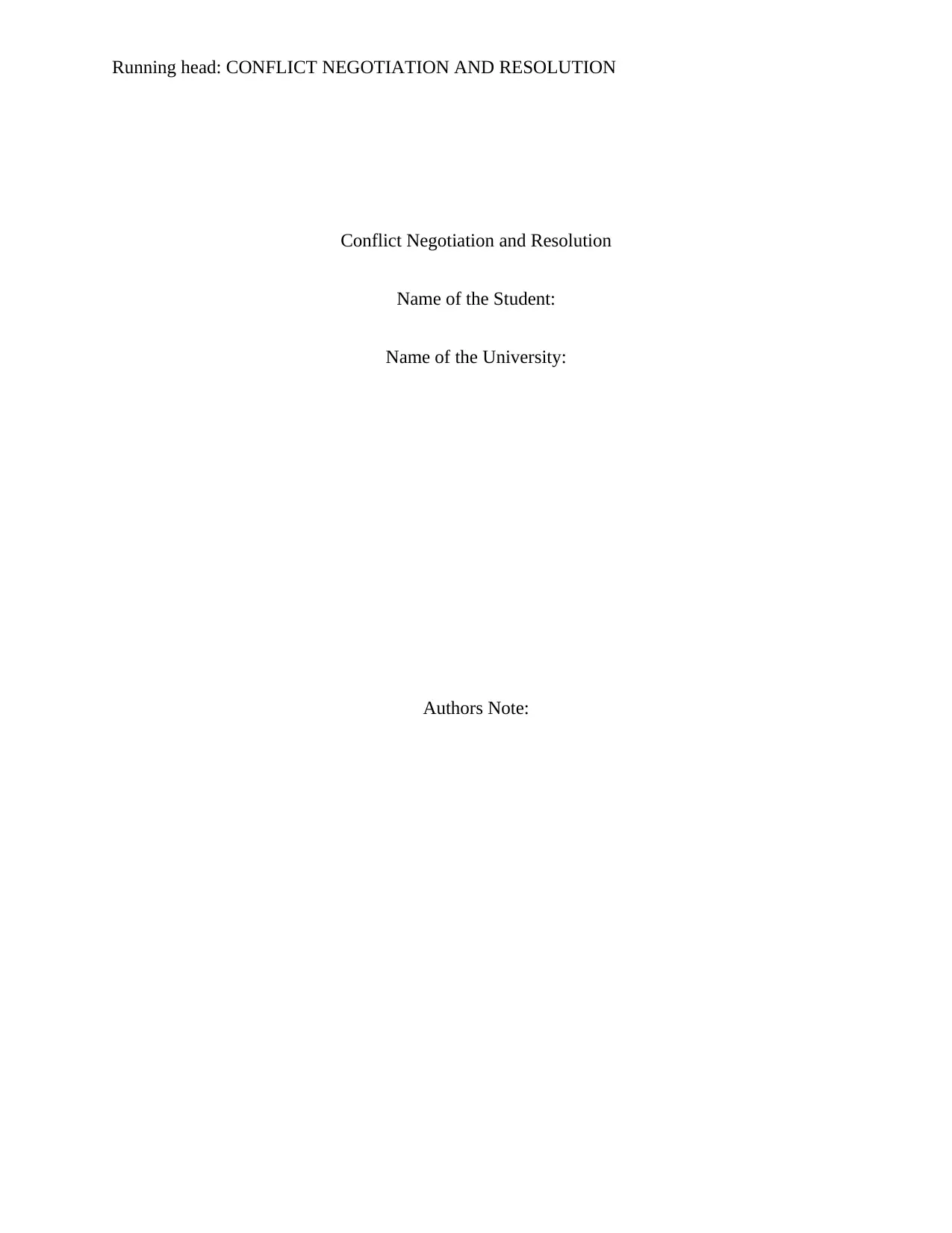
Running head: CONFLICT NEGOTIATION AND RESOLUTION
Conflict Negotiation and Resolution
Name of the Student:
Name of the University:
Authors Note:
Conflict Negotiation and Resolution
Name of the Student:
Name of the University:
Authors Note:
Paraphrase This Document
Need a fresh take? Get an instant paraphrase of this document with our AI Paraphraser

1
CONFLICT NEGOTIATION AND RESOLUTION
A historical political thriller, Thirteen Days is an American film that revolves around the
Cuban Missile Crisis. A 2001 released the movie shows the perspective of US political
leadership on the 1962 Cuban Missile crisis. The film is often thought to be based on the book,
“Thirteen Days” written by Robert F Kennedy but in reality it is not so.
Part 1:
The two ways used by the parties to communicate tacitly are mentioned below:
I. Placing of intermediate range ballistic missiles in Cuba.
II. Kennedy’s decision of not to attack Cuba initially (Peltonen, 2019).
The two explicit ways that the parties communicate are outlined below:
I. The announcement that US Naval ship will not allow any ships to enter Cuban water.
II. The offer of Soviet to remove missiles from Cuban side by back channel communication.
A personal message by the Soviet Premier Nikita Khrushchev offering to remove the missiles
from Cuba in exchange of the assurance from the US that it would not invade the Cuban soil
definitely played a huge role in negotiating the Cuban missiles crisis in 1962. Thus, the explicit
communication was more effective in avoiding the Cuba missiles crisis.
Part 2:
Following are the two direct threats made by one of the parties to the Cuba Missiles crisis at the
face of the other party:
I. The blockade step taken by the US which is an act of war in itself. The US administration
decided to block all ships from entering the Cuban shore without checking by US naval
forces
CONFLICT NEGOTIATION AND RESOLUTION
A historical political thriller, Thirteen Days is an American film that revolves around the
Cuban Missile Crisis. A 2001 released the movie shows the perspective of US political
leadership on the 1962 Cuban Missile crisis. The film is often thought to be based on the book,
“Thirteen Days” written by Robert F Kennedy but in reality it is not so.
Part 1:
The two ways used by the parties to communicate tacitly are mentioned below:
I. Placing of intermediate range ballistic missiles in Cuba.
II. Kennedy’s decision of not to attack Cuba initially (Peltonen, 2019).
The two explicit ways that the parties communicate are outlined below:
I. The announcement that US Naval ship will not allow any ships to enter Cuban water.
II. The offer of Soviet to remove missiles from Cuban side by back channel communication.
A personal message by the Soviet Premier Nikita Khrushchev offering to remove the missiles
from Cuba in exchange of the assurance from the US that it would not invade the Cuban soil
definitely played a huge role in negotiating the Cuban missiles crisis in 1962. Thus, the explicit
communication was more effective in avoiding the Cuba missiles crisis.
Part 2:
Following are the two direct threats made by one of the parties to the Cuba Missiles crisis at the
face of the other party:
I. The blockade step taken by the US which is an act of war in itself. The US administration
decided to block all ships from entering the Cuban shore without checking by US naval
forces
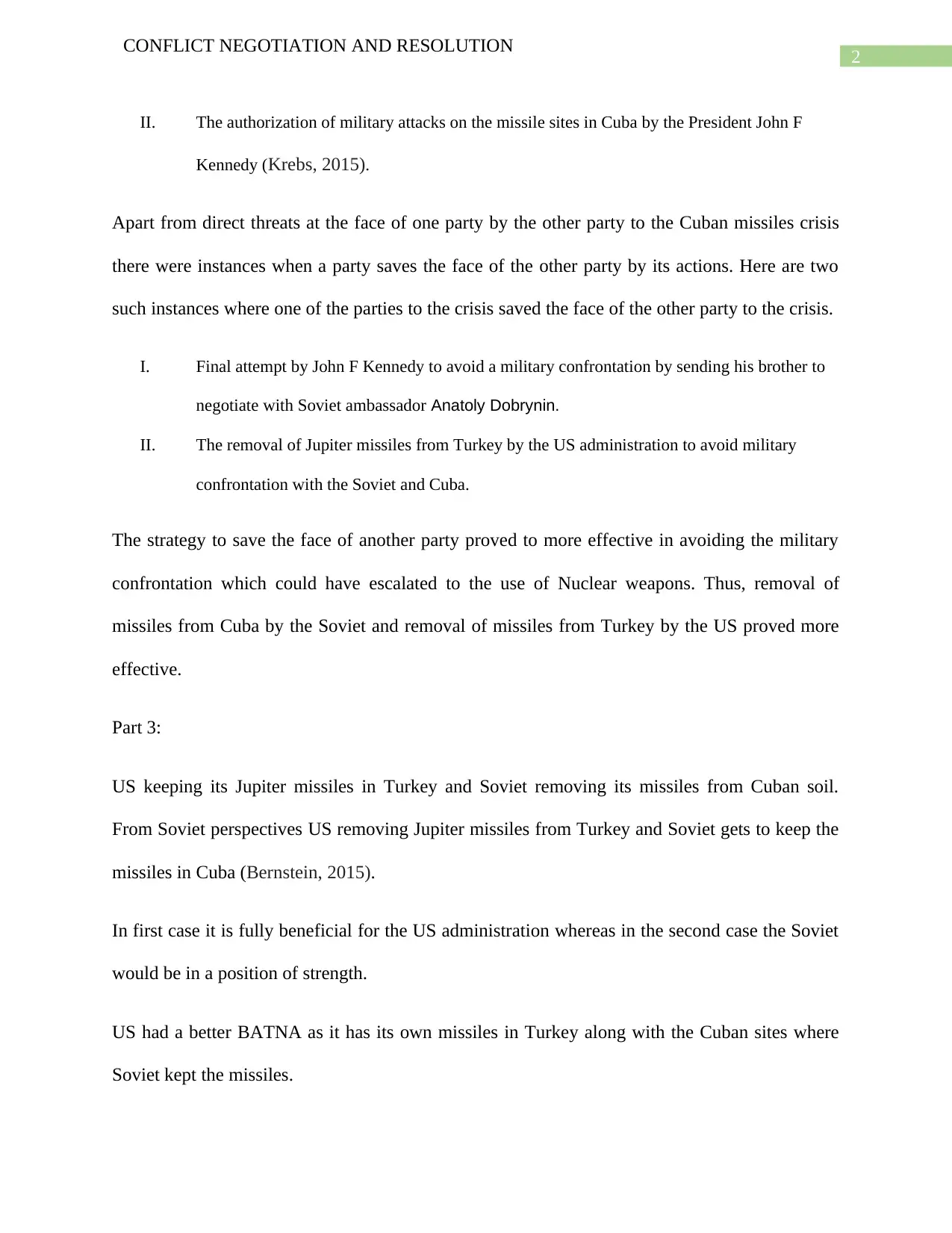
2
CONFLICT NEGOTIATION AND RESOLUTION
II. The authorization of military attacks on the missile sites in Cuba by the President John F
Kennedy (Krebs, 2015).
Apart from direct threats at the face of one party by the other party to the Cuban missiles crisis
there were instances when a party saves the face of the other party by its actions. Here are two
such instances where one of the parties to the crisis saved the face of the other party to the crisis.
I. Final attempt by John F Kennedy to avoid a military confrontation by sending his brother to
negotiate with Soviet ambassador Anatoly Dobrynin.
II. The removal of Jupiter missiles from Turkey by the US administration to avoid military
confrontation with the Soviet and Cuba.
The strategy to save the face of another party proved to more effective in avoiding the military
confrontation which could have escalated to the use of Nuclear weapons. Thus, removal of
missiles from Cuba by the Soviet and removal of missiles from Turkey by the US proved more
effective.
Part 3:
US keeping its Jupiter missiles in Turkey and Soviet removing its missiles from Cuban soil.
From Soviet perspectives US removing Jupiter missiles from Turkey and Soviet gets to keep the
missiles in Cuba (Bernstein, 2015).
In first case it is fully beneficial for the US administration whereas in the second case the Soviet
would be in a position of strength.
US had a better BATNA as it has its own missiles in Turkey along with the Cuban sites where
Soviet kept the missiles.
CONFLICT NEGOTIATION AND RESOLUTION
II. The authorization of military attacks on the missile sites in Cuba by the President John F
Kennedy (Krebs, 2015).
Apart from direct threats at the face of one party by the other party to the Cuban missiles crisis
there were instances when a party saves the face of the other party by its actions. Here are two
such instances where one of the parties to the crisis saved the face of the other party to the crisis.
I. Final attempt by John F Kennedy to avoid a military confrontation by sending his brother to
negotiate with Soviet ambassador Anatoly Dobrynin.
II. The removal of Jupiter missiles from Turkey by the US administration to avoid military
confrontation with the Soviet and Cuba.
The strategy to save the face of another party proved to more effective in avoiding the military
confrontation which could have escalated to the use of Nuclear weapons. Thus, removal of
missiles from Cuba by the Soviet and removal of missiles from Turkey by the US proved more
effective.
Part 3:
US keeping its Jupiter missiles in Turkey and Soviet removing its missiles from Cuban soil.
From Soviet perspectives US removing Jupiter missiles from Turkey and Soviet gets to keep the
missiles in Cuba (Bernstein, 2015).
In first case it is fully beneficial for the US administration whereas in the second case the Soviet
would be in a position of strength.
US had a better BATNA as it has its own missiles in Turkey along with the Cuban sites where
Soviet kept the missiles.
⊘ This is a preview!⊘
Do you want full access?
Subscribe today to unlock all pages.

Trusted by 1+ million students worldwide
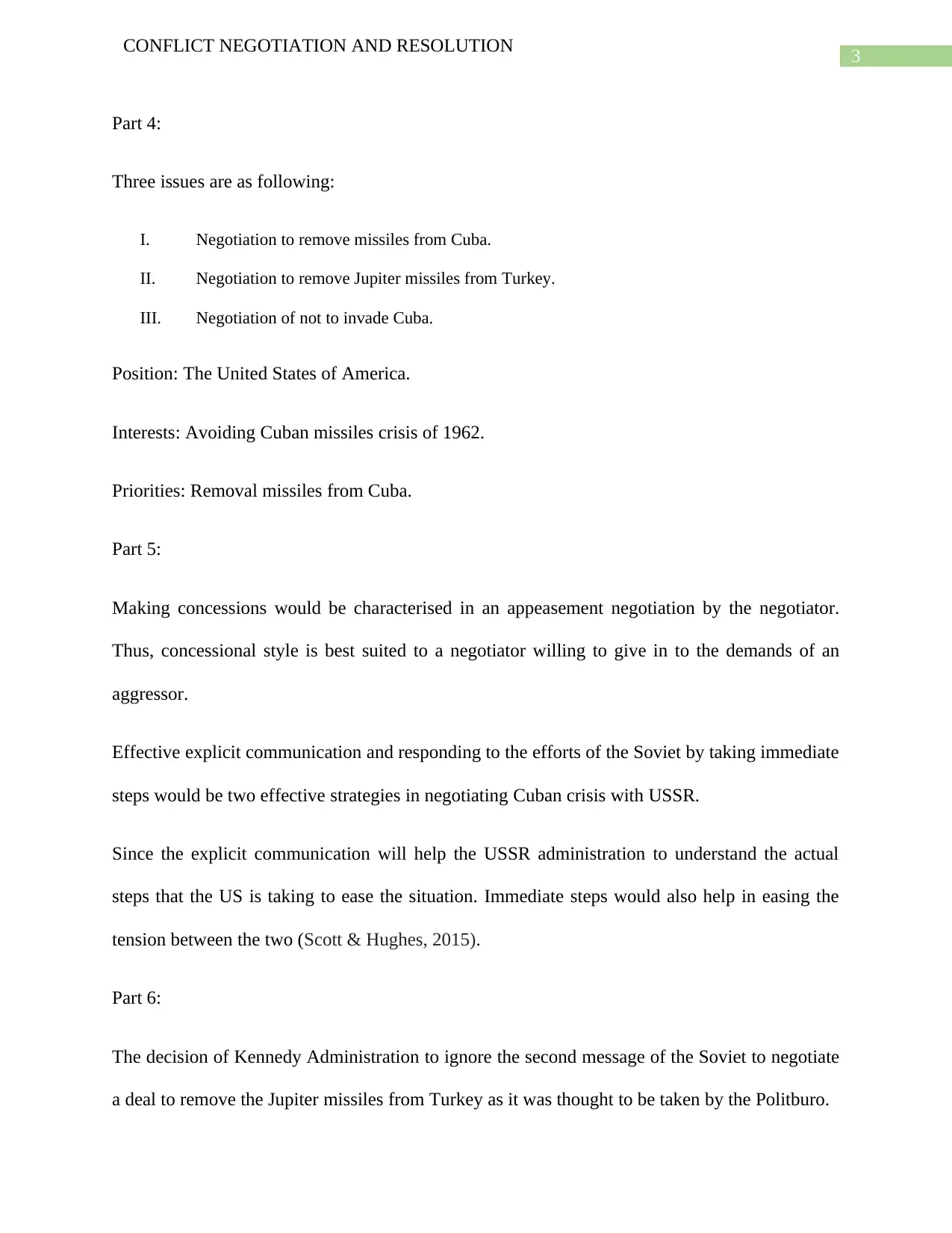
3
CONFLICT NEGOTIATION AND RESOLUTION
Part 4:
Three issues are as following:
I. Negotiation to remove missiles from Cuba.
II. Negotiation to remove Jupiter missiles from Turkey.
III. Negotiation of not to invade Cuba.
Position: The United States of America.
Interests: Avoiding Cuban missiles crisis of 1962.
Priorities: Removal missiles from Cuba.
Part 5:
Making concessions would be characterised in an appeasement negotiation by the negotiator.
Thus, concessional style is best suited to a negotiator willing to give in to the demands of an
aggressor.
Effective explicit communication and responding to the efforts of the Soviet by taking immediate
steps would be two effective strategies in negotiating Cuban crisis with USSR.
Since the explicit communication will help the USSR administration to understand the actual
steps that the US is taking to ease the situation. Immediate steps would also help in easing the
tension between the two (Scott & Hughes, 2015).
Part 6:
The decision of Kennedy Administration to ignore the second message of the Soviet to negotiate
a deal to remove the Jupiter missiles from Turkey as it was thought to be taken by the Politburo.
CONFLICT NEGOTIATION AND RESOLUTION
Part 4:
Three issues are as following:
I. Negotiation to remove missiles from Cuba.
II. Negotiation to remove Jupiter missiles from Turkey.
III. Negotiation of not to invade Cuba.
Position: The United States of America.
Interests: Avoiding Cuban missiles crisis of 1962.
Priorities: Removal missiles from Cuba.
Part 5:
Making concessions would be characterised in an appeasement negotiation by the negotiator.
Thus, concessional style is best suited to a negotiator willing to give in to the demands of an
aggressor.
Effective explicit communication and responding to the efforts of the Soviet by taking immediate
steps would be two effective strategies in negotiating Cuban crisis with USSR.
Since the explicit communication will help the USSR administration to understand the actual
steps that the US is taking to ease the situation. Immediate steps would also help in easing the
tension between the two (Scott & Hughes, 2015).
Part 6:
The decision of Kennedy Administration to ignore the second message of the Soviet to negotiate
a deal to remove the Jupiter missiles from Turkey as it was thought to be taken by the Politburo.
Paraphrase This Document
Need a fresh take? Get an instant paraphrase of this document with our AI Paraphraser
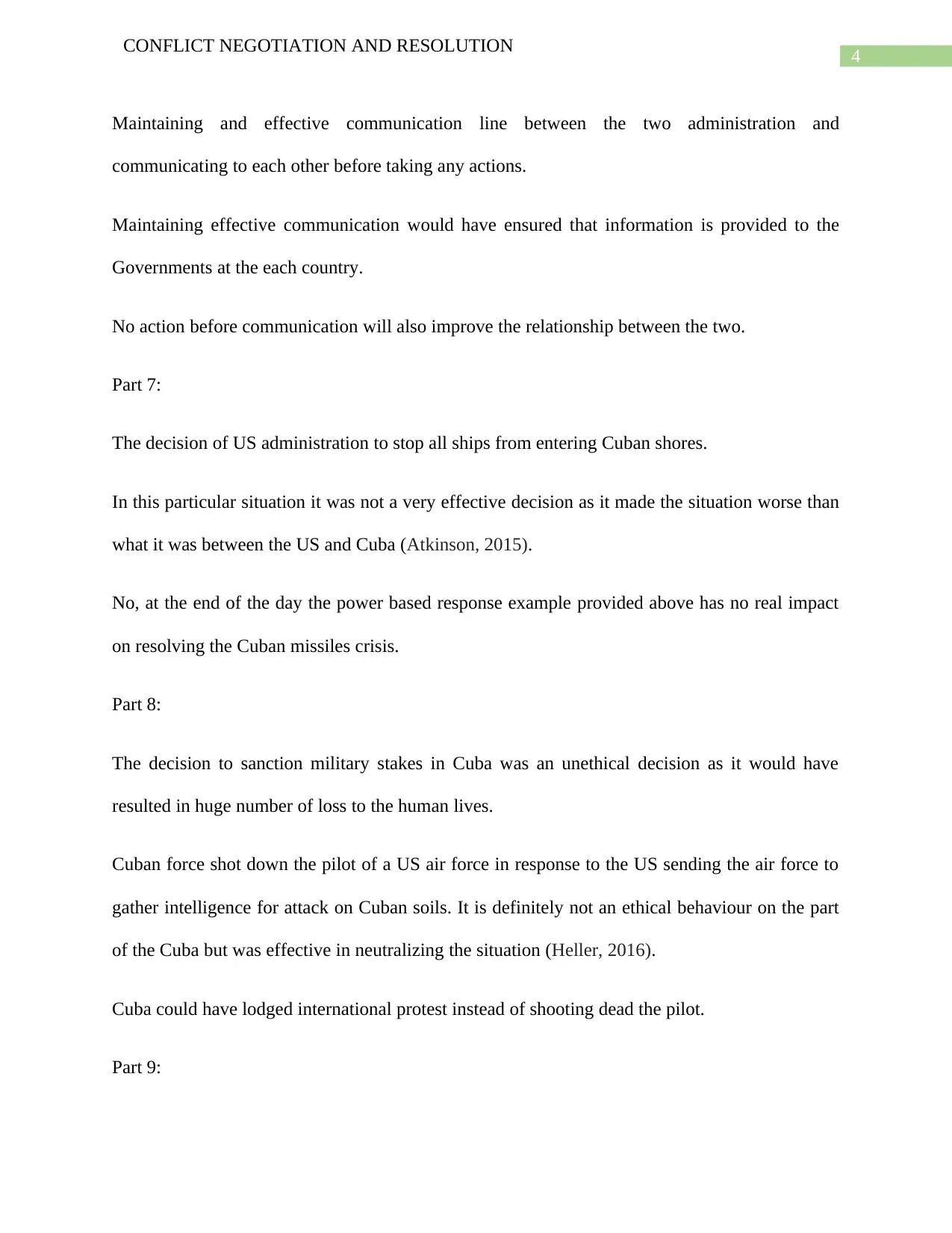
4
CONFLICT NEGOTIATION AND RESOLUTION
Maintaining and effective communication line between the two administration and
communicating to each other before taking any actions.
Maintaining effective communication would have ensured that information is provided to the
Governments at the each country.
No action before communication will also improve the relationship between the two.
Part 7:
The decision of US administration to stop all ships from entering Cuban shores.
In this particular situation it was not a very effective decision as it made the situation worse than
what it was between the US and Cuba (Atkinson, 2015).
No, at the end of the day the power based response example provided above has no real impact
on resolving the Cuban missiles crisis.
Part 8:
The decision to sanction military stakes in Cuba was an unethical decision as it would have
resulted in huge number of loss to the human lives.
Cuban force shot down the pilot of a US air force in response to the US sending the air force to
gather intelligence for attack on Cuban soils. It is definitely not an ethical behaviour on the part
of the Cuba but was effective in neutralizing the situation (Heller, 2016).
Cuba could have lodged international protest instead of shooting dead the pilot.
Part 9:
CONFLICT NEGOTIATION AND RESOLUTION
Maintaining and effective communication line between the two administration and
communicating to each other before taking any actions.
Maintaining effective communication would have ensured that information is provided to the
Governments at the each country.
No action before communication will also improve the relationship between the two.
Part 7:
The decision of US administration to stop all ships from entering Cuban shores.
In this particular situation it was not a very effective decision as it made the situation worse than
what it was between the US and Cuba (Atkinson, 2015).
No, at the end of the day the power based response example provided above has no real impact
on resolving the Cuban missiles crisis.
Part 8:
The decision to sanction military stakes in Cuba was an unethical decision as it would have
resulted in huge number of loss to the human lives.
Cuban force shot down the pilot of a US air force in response to the US sending the air force to
gather intelligence for attack on Cuban soils. It is definitely not an ethical behaviour on the part
of the Cuba but was effective in neutralizing the situation (Heller, 2016).
Cuba could have lodged international protest instead of shooting dead the pilot.
Part 9:
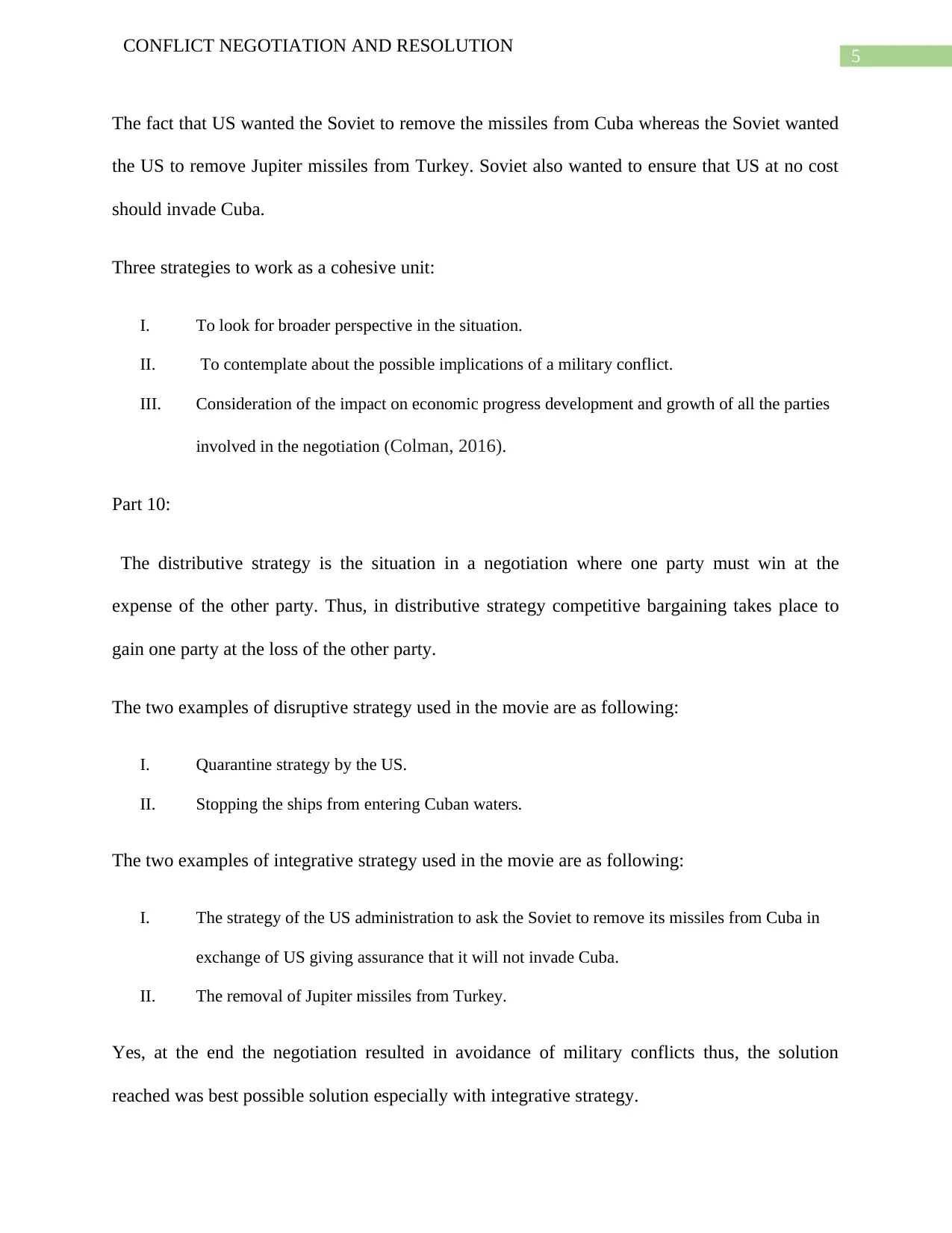
5
CONFLICT NEGOTIATION AND RESOLUTION
The fact that US wanted the Soviet to remove the missiles from Cuba whereas the Soviet wanted
the US to remove Jupiter missiles from Turkey. Soviet also wanted to ensure that US at no cost
should invade Cuba.
Three strategies to work as a cohesive unit:
I. To look for broader perspective in the situation.
II. To contemplate about the possible implications of a military conflict.
III. Consideration of the impact on economic progress development and growth of all the parties
involved in the negotiation (Colman, 2016).
Part 10:
The distributive strategy is the situation in a negotiation where one party must win at the
expense of the other party. Thus, in distributive strategy competitive bargaining takes place to
gain one party at the loss of the other party.
The two examples of disruptive strategy used in the movie are as following:
I. Quarantine strategy by the US.
II. Stopping the ships from entering Cuban waters.
The two examples of integrative strategy used in the movie are as following:
I. The strategy of the US administration to ask the Soviet to remove its missiles from Cuba in
exchange of US giving assurance that it will not invade Cuba.
II. The removal of Jupiter missiles from Turkey.
Yes, at the end the negotiation resulted in avoidance of military conflicts thus, the solution
reached was best possible solution especially with integrative strategy.
CONFLICT NEGOTIATION AND RESOLUTION
The fact that US wanted the Soviet to remove the missiles from Cuba whereas the Soviet wanted
the US to remove Jupiter missiles from Turkey. Soviet also wanted to ensure that US at no cost
should invade Cuba.
Three strategies to work as a cohesive unit:
I. To look for broader perspective in the situation.
II. To contemplate about the possible implications of a military conflict.
III. Consideration of the impact on economic progress development and growth of all the parties
involved in the negotiation (Colman, 2016).
Part 10:
The distributive strategy is the situation in a negotiation where one party must win at the
expense of the other party. Thus, in distributive strategy competitive bargaining takes place to
gain one party at the loss of the other party.
The two examples of disruptive strategy used in the movie are as following:
I. Quarantine strategy by the US.
II. Stopping the ships from entering Cuban waters.
The two examples of integrative strategy used in the movie are as following:
I. The strategy of the US administration to ask the Soviet to remove its missiles from Cuba in
exchange of US giving assurance that it will not invade Cuba.
II. The removal of Jupiter missiles from Turkey.
Yes, at the end the negotiation resulted in avoidance of military conflicts thus, the solution
reached was best possible solution especially with integrative strategy.
⊘ This is a preview!⊘
Do you want full access?
Subscribe today to unlock all pages.

Trusted by 1+ million students worldwide

6
CONFLICT NEGOTIATION AND RESOLUTION
CONFLICT NEGOTIATION AND RESOLUTION
Paraphrase This Document
Need a fresh take? Get an instant paraphrase of this document with our AI Paraphraser
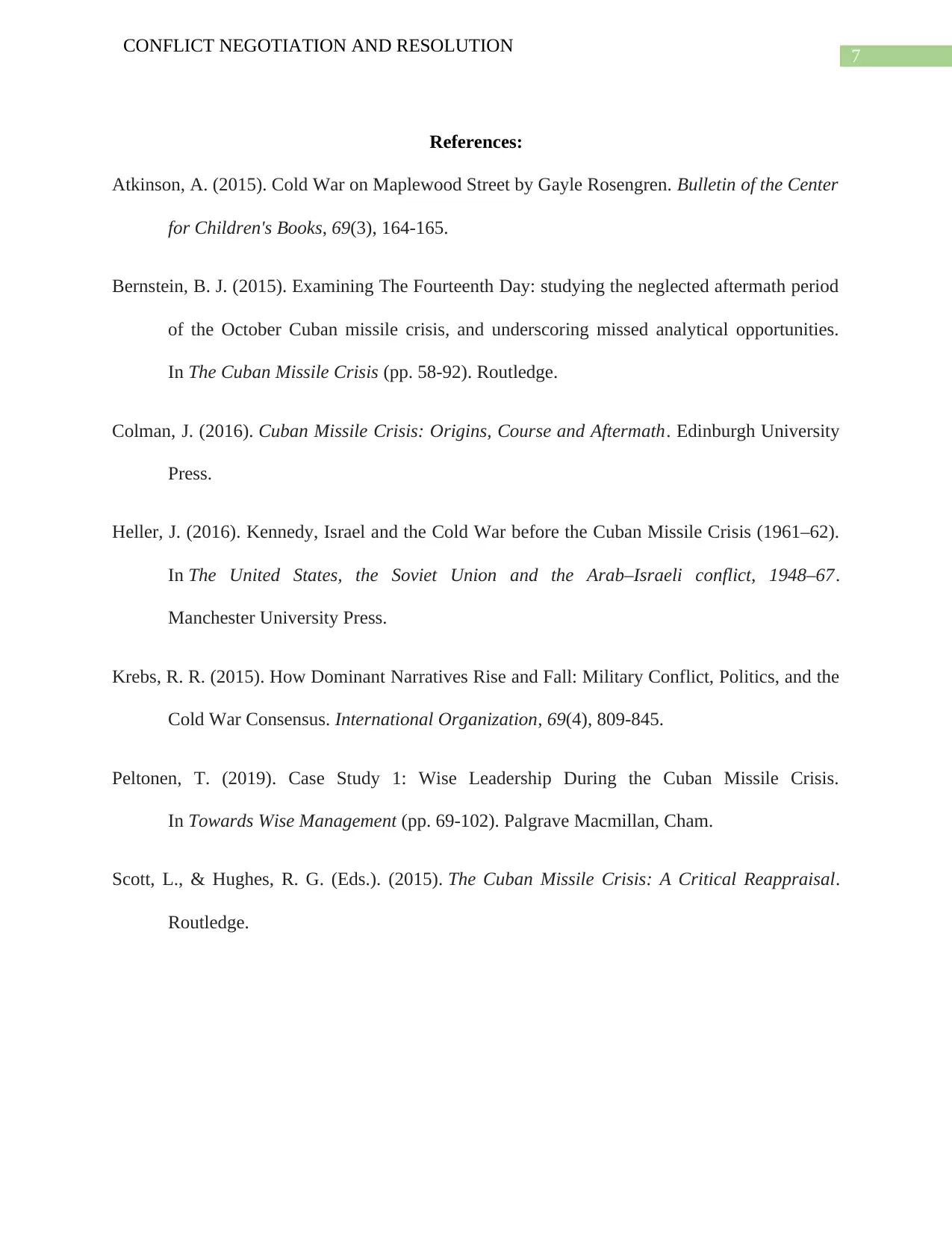
7
CONFLICT NEGOTIATION AND RESOLUTION
References:
Atkinson, A. (2015). Cold War on Maplewood Street by Gayle Rosengren. Bulletin of the Center
for Children's Books, 69(3), 164-165.
Bernstein, B. J. (2015). Examining The Fourteenth Day: studying the neglected aftermath period
of the October Cuban missile crisis, and underscoring missed analytical opportunities.
In The Cuban Missile Crisis (pp. 58-92). Routledge.
Colman, J. (2016). Cuban Missile Crisis: Origins, Course and Aftermath. Edinburgh University
Press.
Heller, J. (2016). Kennedy, Israel and the Cold War before the Cuban Missile Crisis (1961–62).
In The United States, the Soviet Union and the Arab–Israeli conflict, 1948–67.
Manchester University Press.
Krebs, R. R. (2015). How Dominant Narratives Rise and Fall: Military Conflict, Politics, and the
Cold War Consensus. International Organization, 69(4), 809-845.
Peltonen, T. (2019). Case Study 1: Wise Leadership During the Cuban Missile Crisis.
In Towards Wise Management (pp. 69-102). Palgrave Macmillan, Cham.
Scott, L., & Hughes, R. G. (Eds.). (2015). The Cuban Missile Crisis: A Critical Reappraisal.
Routledge.
CONFLICT NEGOTIATION AND RESOLUTION
References:
Atkinson, A. (2015). Cold War on Maplewood Street by Gayle Rosengren. Bulletin of the Center
for Children's Books, 69(3), 164-165.
Bernstein, B. J. (2015). Examining The Fourteenth Day: studying the neglected aftermath period
of the October Cuban missile crisis, and underscoring missed analytical opportunities.
In The Cuban Missile Crisis (pp. 58-92). Routledge.
Colman, J. (2016). Cuban Missile Crisis: Origins, Course and Aftermath. Edinburgh University
Press.
Heller, J. (2016). Kennedy, Israel and the Cold War before the Cuban Missile Crisis (1961–62).
In The United States, the Soviet Union and the Arab–Israeli conflict, 1948–67.
Manchester University Press.
Krebs, R. R. (2015). How Dominant Narratives Rise and Fall: Military Conflict, Politics, and the
Cold War Consensus. International Organization, 69(4), 809-845.
Peltonen, T. (2019). Case Study 1: Wise Leadership During the Cuban Missile Crisis.
In Towards Wise Management (pp. 69-102). Palgrave Macmillan, Cham.
Scott, L., & Hughes, R. G. (Eds.). (2015). The Cuban Missile Crisis: A Critical Reappraisal.
Routledge.
1 out of 8
Related Documents
Your All-in-One AI-Powered Toolkit for Academic Success.
+13062052269
info@desklib.com
Available 24*7 on WhatsApp / Email
![[object Object]](/_next/static/media/star-bottom.7253800d.svg)
Unlock your academic potential
Copyright © 2020–2026 A2Z Services. All Rights Reserved. Developed and managed by ZUCOL.





